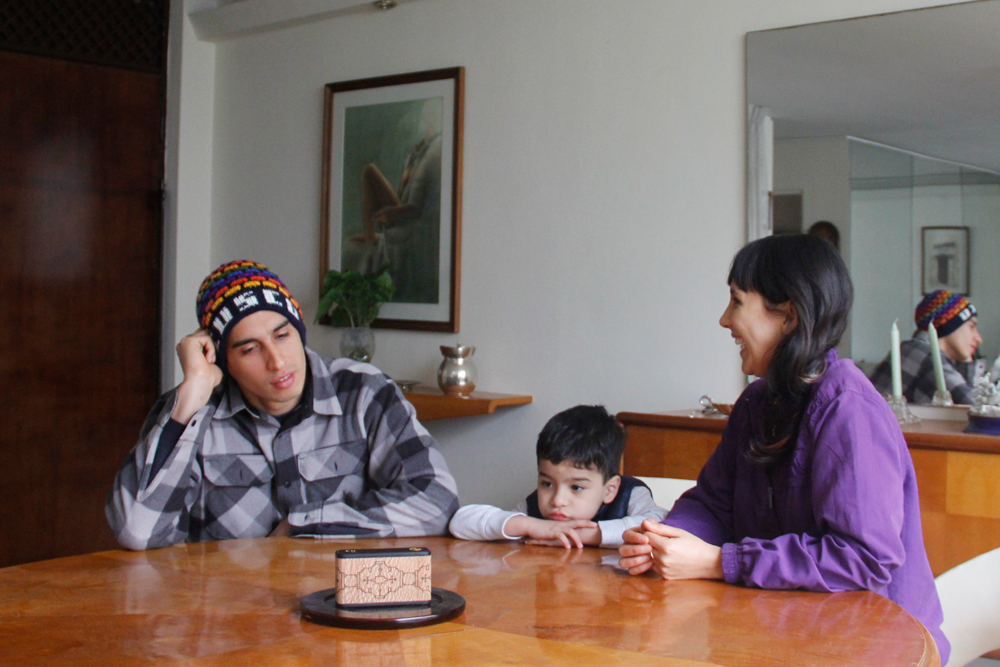A project by Aida limón, Cynthia Santos, Gisell Holguín, Lima, Peru
“It is a way to keep the dead alive and to realize how we evolved generation after generation ”
Preserve the Memory
Juan y Samiq habían quedado en comer al día siguiente. Sus pulseras se encargaron de establecer una hora en la que los dos estuviesen disponibles.
Llegada la hora en que Juan se tenía que alistar para el encuentro, su ropero tenia listas las sugerencias de ropa adecuada según el clima del día y el tipo de evento. La pulsera de Samiq le aviso cuando Juan había llegado. Los amigos decidieron que cocinarían algo pues pronto seria la hora de almorzar. Samiq consultó con el dispositivo de la cocina qué recetas se podían preparar con los ingredientes disponibles en el edificio. El dispositivo guardaba en sí recetas contemporáneas como recetas grabadas por su abuela. Decidieron que cocinarían arroz Haylli, y en cuestión de minutos los ingredientes necesarios estuvieron listos en el buzón de la cocina. Los amigos fueron guiados paso a paso en la preparación de su platillo. Durante el proceso los dos reconocían que la experiencia de cocinar los hacía sentir vivos, el olor, los colores y texturas de los ingredientes los satisfacía. También disfrutaban el hecho de preparar una receta que sabían que sus antepasados comían muchos años atrás.
Al estar lista la comida, alistaron el espacio para comer en los platos modulares que mantienen la comida caliente y advierten al terminar de comer en qué color de buzón deben echarse los residuos. Juan y Samiq, se separan. Juan debe ir a una taller de intercambio de música experimental y Samiq tiene una reunión familiar.
Juan and Samiq had agreed to get together for lunch the next day. Their digital bracelets were in charge to establish a convenient time for both to meet.
When the time to get ready came, Juan's wardrobe had suggestions ready for him about possible suitable clothes according to the weather of the day and the type of event. Samiq's bracelet notified Juan of Juan's arrival. The two friends decided to start cooking something because lunchtime was approaching. Samiq consulted with the kitchen device what recipes could be prepared with the ingredients available in the building. The device's archive contained modern recipes and as well as the ones recorded by his grandmother. They decided they would cook "Haylli" rice, and in a matter of minutes the necessary ingredients were ready in the kitchen mailbox. The friends were guided step by step in the preparation of their dish. During the process they both recognized that the cooking experience made them feel alive, the smell, the colors and textures of the ingredients satisfied them. They also enjoyed preparing a recipe they knew their ancestors ate many years ago.
When the food was ready, they prepared the dining table using modular dishes that helped keeping the food warm. When the food was finished the dishes changed color indicating the recycling nature of the leftover.
Juan and Samiq split up. Juan must go to an experimental music workshop while Samiq has a family reunion.
The pattern edged on the surface of the object has been designed in collaboration with the indigenous Shipibo comunity in Cantagallo, Lima. With an estimated population of over 20,000, the Shipibo-Conibo represent approximately 8% of the indigenous registered population. Originally from the the Amazonian forest, large amounts of the population have relocated to urban areas to gain access to better educational and health services, as well as to look for alternative sources of monetary income.
Dispositivo que almacena historias a través de generaciones, para que estas sigan vivas por más que sus protagosnitas ya no estén vivos. Es una manera de mantener vivos a los muertos, de darnos cuenta cómo evolucionamos generación tras generación y de obtener datos de nuestros familiares a partir de su ADN.
Device that stores stories through generations, so that they remain alive even if their protagonists are no longer with us. It is a way to keep alive the dead, to realize how we evolve generation after generation and to obtain data from our relatives from their DNA.






